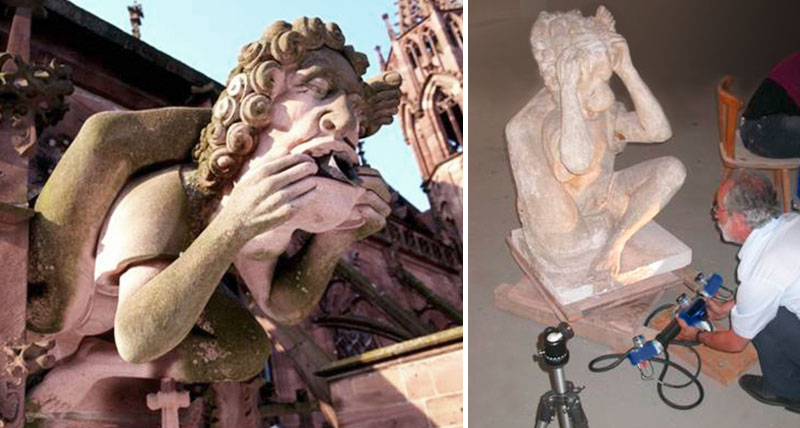The Gargoyles of the Freiburg Cathedral
Freiburg Cathedral - Germany
Contact us

The figure of speech „carved in stone“ implies eternal and indestructible, a fact which however does unfortunately not apply to the unique architectural decoration features of the Freiburg Cathedral in Germany. In fact, very real ravages of time are chipping away especially at the exterior masonry: Weathering and increasing air pollution are taking their toll on the variously shaped reliefs and sculptures, transforming the medieval building into an extensive continuous construction site.
Since 1890, the Münsterbauverein (Cathedral Construction Association) has been responsible for the stone exterior and the building conservation of the Freiburg Cathedral. For this purpose, it is operating the more than 800 years old Münsterbauhütte (Cathedral Stonemasons' Lodge), where stone masons and stone carvers apply traditional craftsmanship to maintain and preserve this unique building. In addition, the versatile 3D data of the SmartScan makes it very own contribution to the conservation of this church monument.
Objective and measuring object
 The Freiburg Münsterbauverein is in the possession of a very special treasure: The collection of over 4000 copies of sculptures and building fragments of the Freiburg Cathedral is of inestimable value for both restoration projects as well as for the purpose of scientific documentation. At the commencement of the nowadays very extensive gypsum collection of the Münsterbauverein, nobody thought about photographs or three-dimensional scan data. Even today, stone masons are still using this archive of patterns and forms in order to reconstruct any damaged shapes.
The Freiburg Münsterbauverein is in the possession of a very special treasure: The collection of over 4000 copies of sculptures and building fragments of the Freiburg Cathedral is of inestimable value for both restoration projects as well as for the purpose of scientific documentation. At the commencement of the nowadays very extensive gypsum collection of the Münsterbauverein, nobody thought about photographs or three-dimensional scan data. Even today, stone masons are still using this archive of patterns and forms in order to reconstruct any damaged shapes.
Among the numerous plaster casts is a gargoyle known under the names of ‘Maulaufreisser’ (gaping mouth gargoyle), ‘Akrobat’ (acrobat) and ‘Zanner’ (mascaron). The purpose of its 3D scan data is to support the work of the Münsterbauverein in a special way — for the creation of souvenirs made of different materials.
Measuring system and setup
For the three-dimensional capture of the ‘Maulaufreisser’, the SmartScan with a field of view of 600 mm and a camera resolution of 2 megapixels is called into action. This scanner is specifically designed for the high demands in the context of the 3D data acquisition of works of art and cultural artefacts as it not only generates precise, high-resolution 3D models but also allows for the texturing of the object surface in its true colors.
Thanks to its modular configuration, the cameras (color or black and white) and the measuring fields of the SmartScan system can be individually adjusted to the client project. In the case of the project described, the scanner was moved around the ‘Maulaufreißer’ in order to capture it from all sides. As an alternative option for a partially automated capture, the TurnTable-300 can be used: It is specifically designed for heavyweight scanning objects, such as a gargoyle with a weight of 250 kg.
Workflow
 First, the SmartScan captures the gargoyle from all sides. Thanks to the flexible sensor configuration allowing for simultaneous scanning processes at triangulation angles of 30°, 20° and 10°, even object areas which are difficult to access can be scanned swiftly and precisely.
First, the SmartScan captures the gargoyle from all sides. Thanks to the flexible sensor configuration allowing for simultaneous scanning processes at triangulation angles of 30°, 20° and 10°, even object areas which are difficult to access can be scanned swiftly and precisely.
The AICON Software OptoCat then aligns the individual images based on the contour of the gargoyle and combines them into a coherent triangle mesh. This 3D data set can subsequently be prepared in the desired size for any further processing, e.g. for model making — or in this project, even for the creation of customized silver jewelry.
Result
Using the 3D data of the SmartScan, a modern archive of digitized sculptures and construction components can be created, thus expanding the application possibilities in connection with the original or plaster replicas: The third dimension of a figure or a relief provides a detailed basis for scientific analysis and documentations; furthermore, the data serves as a fundamental support for professional restoration or reconstruction tasks.
The virtual copy of the gargoyle can be adjusted to any scale and serves as basis for model and mold making or rapid prototyping. Using the digital templates, true to original replica in any desired size can be created with the help of milling templates, casting molds or 3D printers. These replica can be used in many ways, e.g. in exhibitions, in study collections or as souvenirs.
The Freiburg Münsterbauverein uses the SmartScan data of the ‘Maulaufreisser‘ to create 1:1 replicas made of concrete, smaller copies made of stone repair mortar and jewelry figurines made of silver. The ‘Maulaufreisser’ donates his ‘salary’ to a good cause: all sales proceeds go back into the conservation of the Freiburg Cathedral.
Our special appreciation goes to Mrs. Zebura of the Freiburger Münsterbauverein e.V. and Mr. Graf of the company Birkenmeier for providing the information as well as the image material for this project.